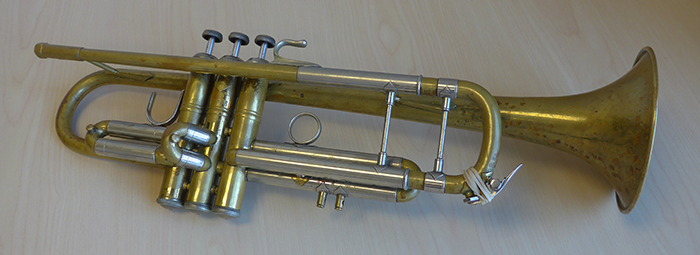
The concert is scheduled to begin in seven minutes. Your trumpet soloist, hands sweaty with excitement, drops his horn. The entire room is silenced by the sickening sound of it hitting the floor and coming apart. What do you do?
Of course you patch the horn together, using anything you can.
Emergency instrument repair is a way of life for band directors. Today I’d like to share a few tips on these “field” repairs, from the perspective of the repair shop, with the goal of minimizing damage and repair expense.
Duct Tape
Everyone is familiar with the many uses of the ever popular fix-it-all tool, duct tape. It can bind most things together. My recommendation is that you never use it (or other sticky tape) on band instruments. My reasoning? Duct tape, the good stuff, has a lot of adhesive on it. These adhesives can be very difficult to remove and usually require the use of a solvent, like denatured alcohol, to finish cleaning the surface before the repair can begin.
This is how we see it in the repair shop: Someone brings in a trumpet with a brace or finger hook that has been carefully bound together with duct tape. The actual repair, the time it will take me to solder together the pieces, will take a few minutes. On the other hand, the removal of the tape, and the complete removal of the solvent might take up to 15 minutes, easily tripling the repair charge.
Super Glue
Yes, superglue sticks things together; even fingers. Just like duct tape, I believe its best uses lie outside the band room. I have three problems with superglue. First, it’s very hard to remove. More importantly, if your repair person does not remove it all and they start heating the brace with a torch, the fumes might just do them in: the result is toxic and should be avoided if at all possible. Finally, superglue has a way of going all over places where you did not intend for it to go.
For example, it might also cover the outside surface of the pieces you are trying to join, making an even harder task of cleaning and saving the finish of the instrument. Superglue can spell disaster for finishes AND repair persons, both of which are difficult and costly to replace!
What Instrument Repair Options Remain?
At this point you may suspect that my only recommendation is that you have a full-time repair person (like myself) on hand at all times. While that might be nice, I do have some practical, affordable solutions that you may already have at hand.
Use some rubber bands.
In situations where you can use them, they hold well, can be removed instantly with one careful swipe of a razor blade, and rarely leave any residue (especially when used for short periods of time). They are temporary solutions, however. Rubber can have a chemical reaction (damaging silver finishes in particular) in fairly short order. Especially on these finishes hair ties would be an even better solution, as the elastic band is wrapped with soft cloth. The “ouchless” varieties, without any metal pieces, are the best.
Zip ties are another low-cost solution. These are the plastic strips that loop through themselves and can be pulled tight to fasten a wide variety of items. You can get them inexpensively in bulk at most hardware stores, and they are also easy to remove and leave no residue.
Using a Rubber Band on a Spit Valve
Not certain how to wrap a rubber band around a spit valve? Check out the photos below. Editor’s note: For an accompanying soundtrack, check out the song: “Tom Fixed His Spit Valve Spring.”
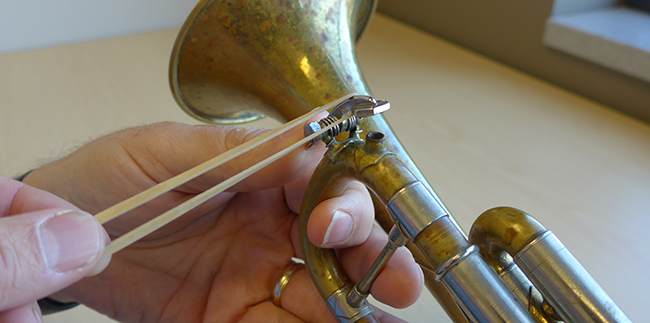
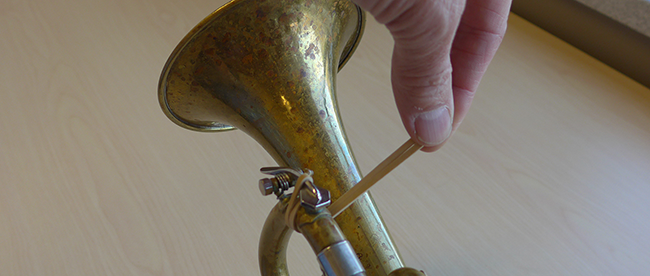

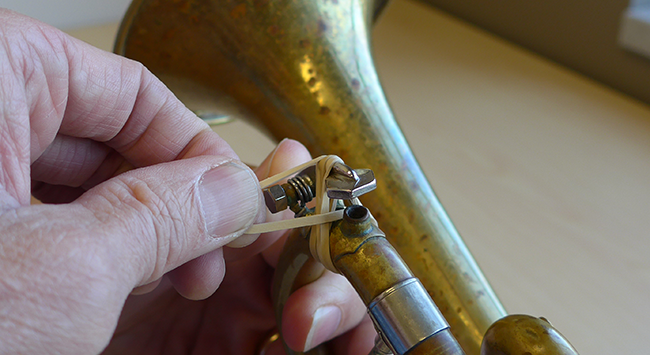
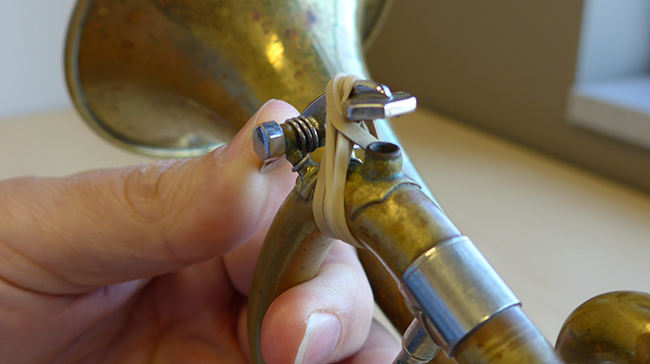
If You Must Use Tape
If you really feel the need to use tape I do have some suggestions for you. Find a tape with a very low amount of adhesive such as plumbers tape, Scotch Artist Tape, or medical tape. Again, remember this is a temporary solution.
I hope this saves you some time, your students some money, and my fellow repair people some grief!
 Al Asmus has played saxophones for almost a half of century. He’s performed with the Temptations, Martha and the Vandellas, Johnny Rivers, Bobby Vee, Ben E. King, Andy Williams and many others.
Al Asmus has played saxophones for almost a half of century. He’s performed with the Temptations, Martha and the Vandellas, Johnny Rivers, Bobby Vee, Ben E. King, Andy Williams and many others.
Asmus spent three years with the 6th Army Band in San Francisco, and later graduated from the band instrument repair program at Red Wing Vocational School. He began repairing wind instruments full time in 1981. Always looking for ways to improve the craft he started using ultrasonic technology for instrument cleaning in 1997.
Today he runs Al Asmus Band Instruments in Saint Cloud, MN. A full-service band shop, they offer new and used instruments, repair service, rentals, supplies, and lessons. After 35 years of experience in the industry Al still loves it each and every day.
Read additional tips from Al, as well as repair tips from other authors, all on the SmartMusic Blog.